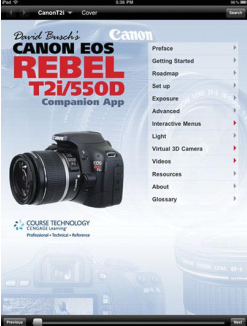Inside Your Digital SLR PART-1
Figure 1.2
Portable apps like this one from iTunes provide guidance and enhancements for your dSLR.
You don’t need to know anything about internal combustion to operate an automobile,
and you really don’t need to understand digital technology to use a point-and-shoot digital camera, either. Both devices are so automated these days that there’s not a lot for
the driver/shooter to do other than point the machinery in the right direction and press
the gas pedal or shutter release. Even if you decide to use manual controls on a nondSLR, the only things you must understand are that this button makes the picture lighter
or darker, that one helps freeze action, and this other button changes the way the camera focuses.
However, if you really want to master a digital SLR, you can benefit from understanding exactly how the camera’s components provide you with a much finer degree of control over your images than the typical point-and-shoot camera. Unlike digital snapshot
photography, where it’s almost impossible to adjust depth-of-field, and usable ISO ratings range from ISO 100 to ISO 100 (just kidding!), the technology built into a dSLR
does allow you to make a difference creatively and technically, if you know what you’re
doing. And for the average serious photographer, that’s what taking pictures is all about.
With a digital SLR, it’s easy to use depth-of-field to manipulate your images, but you
need to understand how digital cameras work with lenses and their apertures. The
“graininess” of your pictures is under your control, too, but it depends heavily on things like the size of the sensor, the sensitivity setting you’re using, and what kind of noise
reduction technology is built into your camera, and how you choose to apply it. If noise
is bad, then noise reduction must be good, right? Yet, when you really delve into how
your camera works, you’ll understand that noise reduction can rob your image of sharpness and detail. There are certain types of pictures in which less noise reduction is a better bet, even at a cost of a bit of “grain” in your image.
Or, would you like to take a picture in which a runner is frozen in time, but a streaky
blur trails behind him like The Flash in comic books? You’d better understand the difference between front-sync and rear-sync shutter settings. Interested in using a superlong telephoto lens without a tripod or switching to high shutter speeds? Step up and
learn about image stabilization.
If you’re who I think you are, you don’t see understanding digital SLR technology as a
daunting task, but as an interesting challenge. By the time someone is ready to use all
the features of their digital dSLR, he or she is looking forward to taking greater control
over every aspect of the picture-taking process.
The most comforting thing about digital SLR technology is that, for the most part,
these cameras were designed by engineers who understand photography. Many of the
point-and-shoot digital cameras I have used appear to have been designed by a techie
who was creating cell phones or PDAs last week, and then moved over to digital cameras this week. They operate like computers rather than cameras, have features that
nobody in their right mind actually needs, and often are completely unusable for the
kinds of photography for which they are intended. For example, one alarming trend is
towards pocket-sized digicams that have no optical viewfinder at all. For the majority of
the latest models, it’s necessary to frame every picture using the back-panel LCD, which,
unfortunately, washes out in bright sunlight, and almost forces you to hold the camera
at arm’s length, guaranteeing that powerful image stabilization features are going to be
required to nullify camera shake.
In contrast, digital SLRs are designed by people who understand your needs. They have,
for example, large bright optical viewfinders that provide a reasonable display of approximate depth-of-field, and which can be used under a variety of lighting and viewing
conditions. The designers of dSLR models have been creating such cameras for many
years and know from the feedback they receive what photographers want. So, learning
dSLR technology will be rewarding for you, because you’ll come to understand exactly
how to use features that have been designed to help you be a better and more creative
photographer.
This chapter explains that technology, and will help you when you’re shopping for your
next digital SLR. You’ll have a better understanding of the kinds of technology you
should be looking for in your camera. If you already own a dSLR, after reading this
chapter you’ll know how to put those features to work.

Congratulations @anyruddho! You have completed the following achievement on the Steem blockchain and have been rewarded with new badge(s) :
Click on the badge to view your Board of Honor.
If you no longer want to receive notifications, reply to this comment with the word
STOPDo not miss the last post from @steemitboard: